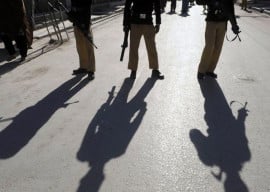“The chief minister should stop trying to defend his incompetence and blaming the dais (traditional birth attendants),” Lala adds in her soft, shaky voice. “We have been doing this for centuries. Children do not die because we are neglectful.” Lala stresses that the children are dying because their mothers are weak and malnourished. Most births are premature. The children are born weak and it is difficult for them to survive in such rough conditions.
A few weeks ago, the Sindh Chief Minister Qaim Ali Shah had blamed untrained midwives for the rising child mortality rates in Tharparkar. They were unfit to deal with the complications that arise during deliveries, he had claimed. His party’s MPA from the area, Khatumal Jeevan, when asked about the CM’s statement, disagrees. “I was born at the hands of a dai too,” he says, shaking his head. “They have conventional wisdom and have been doing this for years.”
Another dai, 45-years-old Seervati, of village Moori Ji Wandh, has helped deliver over 30 babies. None of them have died at birth. “When women get pregnant, they go to the doctors in the city for a check-up, but eventually I deliver the babies.” A mother of ten children herself, Seervati has been helping women deliver babies for over 16 years. Most people are too poor to afford to pay her for her services. Some give her Rs200 to Rs300 as a token of appreciation. When questioned why she thought the infant mortality rate was so high, she blamed it on poor nutrition and lack of awareness. “The women work till the day of their delivery. Their diet consists largely of red chillies and dry bread. How can they sustain their children?” she asks in return. However, Seervati advises that the dais should be more responsible. “If the case looks complicated, they should refer it to the hospital,” she says. Speaking of her own experiences, she says she had referred two mothers-to-be to the Civil Hospital, Mithi. Both were given drips and discharged. She helped deliver their babies herself.
And here lies the problem. In this region that is home to 2,325 registered villages spread over 22,000 square kilometres, there are just three major taluka hospitals, 44 basic health units and 44 dispensaries.
There were three female doctors in all of Thar, at Civil Hospital, Mithi, until May. Now there are 23 to 24 female doctors in the area, and out of them ten to 12 are at Civil Hospital, Mithi.“The women here do pardah,” explains a local journalist, Khatau Jani. In such conditions, the women prefer the dais to the doctors.
There are also other factors. Most are too poor to afford a taxi to the city. If the village is located around 150 kilometres away from Mithi, the taxi fare is almost Rs5,000, and these people do not have that much money to spare. The travelling itself takes a heavy toll on the suffering women as the way is through sand dunes where there is no road-access.
Bherji of village Okaro remembers the time his one-and-a-half year old son, Krishan, had fallen sick and needed to be rushed to the hospital around four years ago. He had arranged for a taxi to take him to Mithi for Rs1,200. But the child died at the hospital. Earlier this year, his one-year-old daughter, Nala, too passed away. “She was suffering from fever and pneumonia,” he says.
When questioned whether he thinks dais are responsible for the high mortality rates, Bherji laughs in response. “If the dais were responsible, the children would have died at birth, not a month or a few years after birth.” He maintains the reason is malnutrition, which is affecting both expecting mothers and the children.
Published in The Express Tribune, November 26th, 2014.
COMMENTS (3)
Comments are moderated and generally will be posted if they are on-topic and not abusive.
For more information, please see our Comments FAQ

















@TK: so beautifully said
@TK:
you are so right...we are all responsible & the politicians of the area & rulers of Sindh will be asked more on the day of judgment......the govt of PPP received Rs 3 trillion in the past 7 years...where have they spent it ? they can get away in the PA as they like, but not on the day of judgment..
who will care for these poor soles? How will we answer Almighty if asked? My mind is numb.